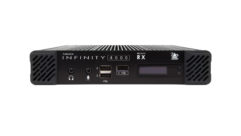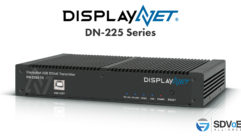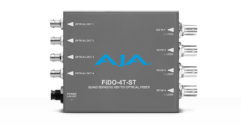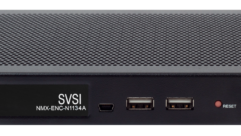
DVI Transmitters and Receivers
Jun 1, 2007 12:00 PM,
By Bennett Liles
Long-distance video signal transmission for go-anywhere capability.

StarTech.com DVIEXTFIBLC
A logical step in the progression of digital video signals and displays is the same one that followed the introduction of analog — particularly VGA, computer output, and its display devices. The many benefits of long-distance video signal transmission resulted in an explosive market for analog transmission devices, and now the digital visual interface (DVI) has brought its need for go-anywhere capability. The need for these signal transmitter/receiver pairs has arisen as a result of the inherent distance limitation of the DVI signal. A few meters from the transmission point, a DVI signal begins to exhibit stuck pixels or jitter, and beyond this, simply disappears.
Increasingly large displays, particularly those used in video signage, requiring more bandwidth than the 165MHz of a single-link DVI signal, have resulted in the use of dual-link DVI transmission for display resolution up to 2048×1536 pixels. While there are single-unit signal boosters available in many forms and sizes to increase and extend the DVI signal, we will look closely here at those DVI extender products that are composed of two individual hardware units — a transmitter and receiver — intended to carry the video signal over different media. These may use Cat-5 cable for the run or employ fiber-optic means to carry single- or dual-link DVI display signals over greater distances.
VERSATILE TECHNOLOGY
The term Extended Display Identification Data (EDID) will be encountered often in a discussion of DVI-extension technology, and in practice, it has proven to be somewhat confusing. EDID is part of the VESA standard enabling monitors to communicate their operational capabilities to the device generating the display. This information can include the manufacturer, product type, phosphor or filter type, timing supported, display size, luminance data, and pixel-mapping data. EDID is also used in analog transmission from computers to monitors and data projectors. The EDID is typically stored on a chip inside the monitor, and it is output on the DDC link back to the transmitter. Most of the products listed here make use of the DDC link in one way or another.

Avocent Emerge MPX1000 HD
Avocent has produced a versatile digital video extension product in the Emerge MPX1000 HD with either Cat-5 or wireless transmission of DVI/HDMI signals, control data, and stereo sound between the MPX1000T transmitter and the MPX1000R receiver. Control and configuration interfaces include a browser-based interface through an onboard web server, an RS-232 serial interface for third-party controllers, and front-panel pushbutton access and navigation through system status displays. Conversion for transmission of analog VGA is accomplished through interchangeable plug-in modules on each unit.
The audio and video signals are encoded with the 128-bit AES encryption standard for security and the input-to-output latency is less than eight frames. The pair is also able to convey signals to allow long-distance control by either RS-232 or infrared extension. Together, the MPX1000 HD transmitter, receiver, and HDMI modules cost around $2,000.
Black Box Network Services offers the AC1070A 3-channel DVI extender for videowalls, industrial control rooms, and other applications with displays up to 1,312ft. from the source, using 12-fiber multimode fiber-optic cable. The basic fiber benefits include immunity from electromagnetic interference and source-display grounding problems. The transmitter can input either analog or digital video, and it features a local DVI monitor output on each channel. Video resolution capacity extends to a 1920×1200 maximum at 60Hz. Configuration and firmware updates are made through an RS-232 interface on the sending unit. The initial setup is made with a CD configuration program with desktop menus for setting brightness, contrast, image position, and screen width. The MSRP for the AC1070A is $4,995.95.
The Pure Digital Fiberlink 7500 Series fiber optic transmission system for DVI over one fiber was unveiled last year and launched a whole family of DVI fiber optic products from Communication Specialties. Available in standalone box and rack card forms, the 7500 Series can send single-link DVI from 640×480 up to 1920×1200 along a fiber link to a distance of 15km. Local high resolution monitoring is available using the DVI monitoring loop through feature on the box version. Easy no-tweaks installation assures twin outputs on the receiver for HDTV in 480p, 720p, 1080i, and 1080p without equalization or de-skewing. The destination DVI displays can be strung up to 16ft. from the receiver while the transmitter can accept a 45ft. line from the source. For monitor compatibility, EDID may be internally generated in the transmitter or passed on the loop-through for the transmit end display. Problem DVI signals are equalized and re-clocked at the transmitter input. Indicator LEDs include power, video, and audio, and on the rack version, an alarm light is provided.
Among the KVM products capable of extending DVI along with their other functions, the Daxten Voyager KVM DVI extender can stretch the reach of a 1600×1200 DVI signal up to nearly 500ft. on Cat-5 or up to 1,640ft. on fiber. The single-head version can connect one local and one remote DVI display, while the dual-head version can serve two of each. The units include LED status lights, including video, power, link, and data, and, with optional hardware, the units are rackmountable.
Among the Cat-5 entries is Extron Electronics‘ DVI 201Tx/Rx for extension of single-link DVI-D or HDMI signals, with up to 1600×1200 resolution at a distance of 200ft. or more over two Cat-5/Cat-5e or Cat-6 cables. A big plus on this product is its support for DDC and HDCP signals for easy display-to-source return communication and copyright security.
The DDC and HDCP signal routing may be switched between the local and remote displays by way of a set of small rear-panel switches. Either unit can accept an external power source and power the other unit over the UTP cable while carrying RS-232 control signals, as well. The transmitting unit includes a buffered DVI loop-through output for a local monitor. The MSRP is $810.
Capable of running a HDMI/DVI video signal up to 200ft. on UTP, the Gefen DVI Cat-5 Extreme uses two Cat-5e cables for resolution up to 1280×1024 at that distance or up to 1920×1200 at 150ft., including DDC support for compliant displays. A model of simplicity, the extender has a 5V power connection and accompanying LED indicator, along with the DVI in and out connectors and a pair of RJ-45s — one for DDC data and the other for video. Tucked under each unit are DIP switches for boosting and equalizing the signal to best match the cable length and type. The manufacturer’s price on the pair is $499.
Maximum throw with minimum size is provided by the Icron Technologies DVI Ranger 500 extender system using a four-cable multimode fiber-optic video link from transmitter to receiver and Cat-5 for DDC. This allows a DDC-matched signal to extend as far as 330ft. (Cat-5 limit), while non-DDC transmission with 1600×1200 resolution and a 60Hz refresh rate can reach up to 1,650ft. The sender and receiver units are equipped with power and status LEDs, 12VDC connection, RJ-45s for the DDC link, and duplex LC connections for the four-line fiber link carrying red, blue, green, and clock. The MSRP on the DVI Ranger 500 is $765.
The Active DVI Balun from Intelix is small enough in its RF-shielded enclosure to fit anywhere, and it carries single-link DVI video up to 150ft. to remote data projectors, plasma screens, or other HD displays on two Cat-5 cables, one shielded for the video signal and the other unshielded for the DDC link. The Active DVI Balun is HDCP-compliant for devices that support HDCP encryption. The 5VDC power supply for the transmitter unit is included, and it lights a red LED when connected. Power consumption is 15W. MSRP is $559.95.
For minimum size and weight in the DVI-on-fiber transmission group, the 610T/610R from Kramer Electronics sends 1600×1200 60Hz DVI video up to 1,640ft. on four fiber-optic lines, using them for red, blue, green, and clock using four simplex or two duplex LC connectors. Each unit uses a separate 5VDC power supply. The 610T transmitter can capture EDID through an initial direct connection to the display, and then store it. When the long-distance connection is made, the EDID will be recalled for the setup. The pair is available for around $500.
Another KVM product with DVI extension capability to its own receiver is the DVI-Fiberlynx digital display extension system from Lantronix. The transmitter unit includes a local DVI display output and can run the 1600×1200 video signal up to 1,200ft. on six multimode fiber-optic cables carrying red, green, blue, clock, data out, and data in. The model also supports the DDC2B standard. The front panel includes status LEDs for the three video channels, receiver, sync, and clock. Each unit is a rackmount design, and the receiver can output video to two DVI displays. The pair retails for around $3,000.
Magenta Research offers a unique approach to DVI extension with the Infinea DVI. Used both as a transmitter and receiver, the Infinea units may be daisy-chained in fiber, copper, or mixed domains to carry 1600×1200 DVI video, along a virtually unlimited (6.2 miles) path on a single-mode fiber-optic line and up to 600ft. on Cat-6 on each leg of the path. Optional versions can add stereo sound and RS-232 control signals.
Just out from MultiDyne is the DVI-5000 for sending single- and dual-link DVI video up to 2048×1536 as far as about 9.3 miles on one single-mode fiber-optic link with throughput of 10Gbps. The receiver provides two outputs, and the system supports EDID from any monitor, along with stereo sound and bidirectional data for monitor control. The transmitter features a loop-through DVI input normally used for a local display.
The Network Technologies ST-FODVI-LC DVI extender takes a single-link DVI signal to a distance of up to 4,950ft. on four multimode fiber-optic lines at two duplex LC connectors. These are used to carry the separate RGB and clock signals. The maximum resolution of the desired signal dictates which of the four available models will be used from 1024×768 up to 1920×1200. Any model will support resolutions below its rated maximum. Each unit is powered by a separate cube-type AC adapter. The price for the pair begins at around $500.
The M1-2R2-TR from Opticis uses a four-cable fiber-optic link to carry single-link 1600×1200 DVI video over 300ft., and includes a separate Cat-5 link for DDC and HDCP data security signals. The 12VDC power adapter may be connected to the transmitter or receiver to power the far unit over the Cat-5 cable, and while the units are tiny enough to fit anywhere, the rack ears allow either to be rackmounted. In cases where the distance is beyond the capabilities of Cat-5, the transmitter EEPROM is programmed to allow video cards to use virtual DDC. The M1-2R2-TR can be found for less than $800.
The CrystalView Fiber digital fiber KVM extender from Rose Electronics can send a DVI signal with a resolution of up to 1920×1200 at 60Hz to a maximum distance of six miles on 9µm single-mode fiber. It is also available in a dual-video model for extending two separate video sources, and the transmitter has a local video monitor output for each video channel. The front panel includes power, status, and data-error LED indicators. The single-channel pair can be found for just more than $2,000.
The smallest entry in this field, the SDL 3501 DVI transmission link, is offered by Siemens to run DVI signals, including DDC support up to 118ft., to its SMC, SCD, and SHD line of digital video monitors on Cat-5. Maximum resolution is 1280×1024, and the transmitter module is powered from the DVI interface, while the receiver can optionally use a 5VDC supply. Separate power supplies are required for non-SMD/SCD/SHD displays.
For no-frills simplicity and reliability in single-link DVI transmission, the DVX200 from SmartAVI is hard to beat. The little DVX-TX200 transmitter and DVX-RX200 receiver can be used as standalone units, or four of them may be put into a 1RU space. Using shielded Cat-5e or Cat-6, the transmitter can send DVI signals with resolutions up to 1920×1200 at 60Hz or 1280×1024 at 74Hz up to 220ft. The unit can operate with DDC information selectable from the remote display, the local display, or from an internal table. The 5VDC power supply is included, and each unit has a green LED power indicator.
The StarTech.com DVIEXTFIBLC DVI extender can operate in either of its two modes to convey DVI video resolutions up to 1600×1200 at 60Hz. When DDC is required, the transmitter and receiver are linked using four fiber-optic cables on duplex LC connections carrying red, blue, green, and clock signals, and a Cat-5 cable is run between the two for the DDC link to carry EDID information from the monitor to the transmitter for a distance up to 330ft. When the DDC link is not required, the fiber-optic cables may be used alone, and the distance can be extended to a maximum of 1,640ft. Each unit has a red LED power indicator and a green LED status light that will activate as soon as the included power adapter is connected.
The VIS-30 DVI video extender from Thinklogical (a subsidiary of Logical Solutions) uses a single fiber-optic cable on an ST connector to carry single-link DVI video and DDC (fully DDC2B-compliant) more than 3,000ft. to the receiver unit using power from the DVI interface to the transmitter. The small transmitter unit includes power- and link-status LEDs, along with a local DVI monitor output connection. When the local monitor is used, the unit requires a separate but included power-supply cube. Power consumption is 3W per unit.
The distance to be covered, the number of displays, the need for a local monitor, KVM capabilities, space considerations, and DDC will all figure into the buying decision, but the wealth of diversity among the products in this field ensure that there is at least one that will be appropriate to any need for digital video extension.
For More Information
Avocent
www.avocent.com
Black Box Network Services
www.blackbox.com
Communications Specialties
www.commspecial.com
Daxten
www.daxten.com
Extron Electronics
www.extron.com
Gefen
www.gefen.com
Icron Technologies
www.icron.com
Intelix
www.intelix.com
Kramer Electronics
www.kramerelectronics.com
Lantronix
www.lantronix.com
Magenta Research
www.magenta-research.com
MultiDyne
www.multidyne.com
Network Technologies
www.networktechinc.com
Opticis
www.opticis.com
Rose Electronics
www.rose.com
Siemens
www.siemens.com
SmartAVI
www.smartavi.com
StarTech.com
www.startech.com
Thinklogical
www.thinklogical.com
Bennett Lilesis a freelance television production engineer and AV technician in the Atlanta area. He specializes in government video production, distance learning, and videoconferencing.










